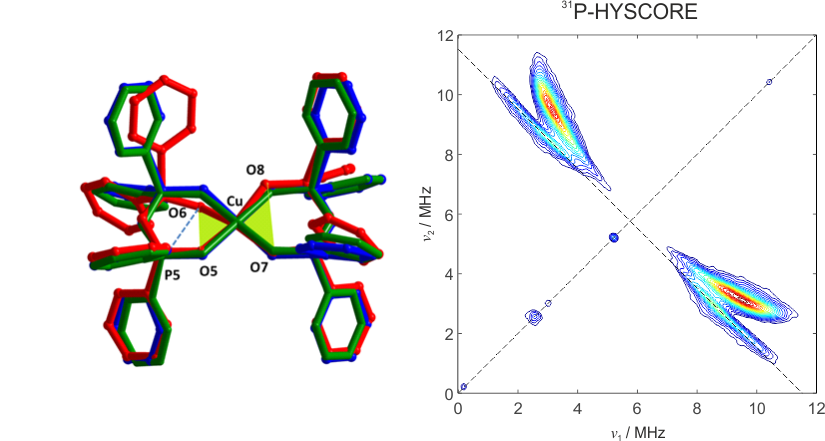Physical Chemistry
EPR characterization of transition metal complexes
Advanced EPR methods offer a means for the structural and electronic characterization of paramagnetic transition metal complexes through the detailed mapping of hyperfine couplings between the unpaired electron and the surrounding magnetic nuclei. In biological systems containing one or more unpaired electrons, EPR spectroscopy can provide unique information on the electronic and geometric structure since magnetic data such as g-values, hyperfine couplings, and nuclear quadrupole parameters are directly related to the electronic wavefunction and the local environment of the paramagnetic center. EPR spectroscopy is well suited for structural studies in systems lacking long-range order on length scales that are not easily accessible by other techniques.
Influence of Hyperfine Coupling Strain on HYSCORE Spectra from I = 1/2 Nuclei

Strain effects on g and metal hyperfine coupling tensors, A, are often manifest in EPR spectra of transition metal complexes, as the result of their intrinsic and/or solvent-mediated structural variations. Although distributions of these tensors are quite common and well understood in cw EPR spectroscopy, reported strain effects on ligand hyperfine coupling constants are rather scarce. Here we explore the case of [Cu{Ph2P(O)NP(O)Ph2}2], a square-planar Cu(II) complex bearing P atoms in its second coordination sphere. The HYSCORE spectra of this complex exhibit correlation ridges that have unusual inverse or so-called “boomerang” shapes and features that cannot be reproduced by standard simulation procedures assuming only one set of magnetic parameters. Our work shows that a distribution of isotropic hyperfine coupling constants spanning a range between negative and positive values is necessary in order to describe in detail the unusual shapes of these HYSCORE spectra.
Characterization of Cu(II) complexes

Electron Paramagnetic Resonance (EPR) is the method of choice for studying the electronic structures of Cu(II) complexes mainly through the analysis of g values and the metal hyperfine coupling constants. While the g and A values can sufficiently describe the first coordination sphere of Cu(II) complexes having high symmetry, they often do not provide unambiguous determination of the bonding parameters. Weaker magnetic interactions (also called superhyperfine interactions to distinguish them from hyperfine coupling with the Cu(II) nucleus) between the unpaired electron and ligand atoms can provide access to a more detailed analysis of the spin density distribution. Such interactions, which include hyperfine and nuclear quadrupole couplings, can be typically probed by pulse EPR methods that allow for measuring nuclear spin transitions with high resolution in solids, even for orientationally disordered systems. The pulse EPR methods for measuring nuclear transition frequencies can be classified into two categories. The first involves Electron Nuclear Double Resonance (ENDOR) techniques, where EPR and NMR transitions are excited in the same sequence by microwave (mw) and radiofrequency (rf ) pulses, respectively. The ENDOR signal arises by measuring the changes of the electron spin echo of a selected EPR transition as a function of the frequency of the rf pulse which is applied between EPR excitation and detection. In the second class of experiments, based on the Electron Spin Echo Envelope Modulation (ESEEM) effect, the nuclear transition frequencies are indirectly measured by the creation and detection of electron or nuclear coherences by using only mw pulses. These coherences are measured as a function of interpulse delays between mw pulses and are modulated with the nuclear frequencies. Therefore, the latter are obtained after a Fourier transform of the time-domain signal without the need for rf irradiation. ENDOR and ESEEM spectra provide complementary information. ENDOR experiments are especially suited for measuring nuclear frequencies above 5 MHz and are often more sensitive to isotropic hyperfine interactions. On the other hand, the ESEEM effect requires anisotropic interactions and can easily measure low nuclear frequencies.
References
- Polypyridyl‐Based Copper Phenanthrene Complexes: Combining Stability with Enhanced DNA Recognition, Nicolò Zuin Fantoni, Zara Molphy, Sinead O'Carroll, Georgia Menounou, George Mitrikas, Marios Krokidis, Chryssostomos Chatgilialoglu, John Colleran, Anna Banasiak, Martin Clynes, Sandra Roche, Suainibhe Kelly, Vickie McKee, Andrew Kellett, Chem. Eur. J. 27, 971-983 (2021) DOI: 10.1002/chem.202001996
- Unusual 31P Hyperfine Strain Effects in a Conformationally Flexible Cu(II) Complex Revealed by Two-Dimensional Pulse EPR Spectroscopy, Nikolaos-Angelos Stamos, Eleftherios Ferentinos, Maria Chrysina, Catherine P. Raptopoulou, Vassilis Psycharis, Yiannis Sanakis, Dimitrios Α. Pantazis, Panayotis Kyritsis, George Mitrikas, Inorg. Chem. 59, 3666−3676 (2020) DOI: 10.1021/acs.inorgchem.9b03237
- In-depth synthetic, physicochemical and in vitro biological investigation of a new ternary V(IV) antioxidant material based on curcumin, E. Halevas, T. A. Papadopoulos, C. H. Swanson, G. C. Smith, A. Hatzidimitriou, G. Katsipis, A. Pantazaki, I. Sanakis, G. Mitrikas, K. Ypsilantis, G. Litsardakis, A.Salifoglou, J. Inorg. Biochem. 191, 94-111 (2019) DOI: 10.1016/j.jinorgbio.2018.10.010
- Polypyridyl-based Copper Phenanthrene Complexes: A New Type of Stabilized Artificial Chemical Nuclease, Fantoni, N., Molphy, Z., Slator, C., Menounou, G., Toniolo, G., Mitrikas, G., McKee, V., Chatgilialoglu, C., Kellett,A., Chem. Eur. J. 25, 221-237 (2019) DOI: 10.1002/chem.201980162
- [Cu(TPMA)(Phen)](ClO4)2: Metallodrug Nanocontainer Delivery and Membrane Lipidomics of a Neuroblastoma Cell Line Coupled with a Liposome Biomimetic Model Focusing on Fatty Acid Reactivity, G. Toniolo, M. Louka, G. Menounou, N. Z. Fantoni, G. Mitrikas, E. K. Efthimiadou, A. Masi, M. Bortolotti, L. Polito, A. Bolognesi, A. Kellett, C. Ferreri, and C. Chatgilialoglu, ACS Omega 3, 15952−15965 (2018) DOI: 10.1021/acsomega.8b02526
- Probing the electronic structure of a copper(II) complex by CW- and pulse-EPR spectroscopy, Z. G. Lada, Y. Sanakis, C. P. Raptopoulou, V. Psycharis, S. P. Perlepes, G. Mitrikas, Dalton Trans. 46, 8458-8475 (2017) DOI: 10.1039/c7dt01785e
- Synthesis, crystal structure and characterization of three novel copper complexes of Levofloxacin. Study of their DNA binding properties and biological activities, A. Galani, E. K. Efthimiadou, G. Mitrikas, Y. Sanakis, V. Psycharis, C. Raptopoulou, G. Kordas, A. Karaliota, Inorganica Chimica Acta423, 207-218 (2014) DOI: 10.1016/j.ica.2014.08.005